Search myodfw.com
While in Oregon, the Pine grosbeak is tame and not suspicious, usually allowing a close approach as it feeds on buds or dried fruits. The soft-gray females and young males, the latter more or less washed with yellow on the head, far outnumber the rosy males, and observers should look carefully for these duller-colored birds. The song of the Pine grosbeak is often described as similar to the Purple finch, but fuller and with lower pitch. The flight is typically finch-like, but with broad, bounding undulations. The Pine grosbeak breeds in the Wallowas and is suspected to breed in the

The bubbly warble of this finch is common in western Oregon conifer forests in summer, while its Crossbill-like - but more delicate - pik call is heard in lowland valleys in the winter. Adult males have a distinctly reddish-colored head, face, rump, throat, and breast, broadly but very faintly streaked brownish-pink sides, and a diffused brownish-red nape, back, and wings. Females and immature males have brownish-olive upperparts, wings, and tail, with contrasting streaking. Underparts are buffy-white to off-white with fuzzy, brownish streaking; a dingy pale gray stripe is present above the eye. In Oregon, the Purple finch breeds west of
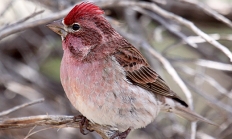
The bubbly warble of this finch is common in western Oregon conifer forests in summer, while its Crossbill-like - but more delicate - pik call is heard in lowland valleys in the winter. Adult males have a distinctly reddish-colored head, face, rump, throat, and breast, broadly but very faintly streaked brownish-pink sides, and a diffused brownish-red nape, back, and wings. Females and immature males have brownish-olive upperparts, wings, and tail, with contrasting streaking. Underparts are buffy-white to off-white with fuzzy, brownish streaking; a dingy pale gray stripe is present above the eye. In Oregon, the Purple finch breeds west of

The House finch is the most widespread of Oregon's "red finches." It is a congenial, cheerful singer from urban areas to desert plateaus. The male has a red forehead, throat, eyebrow, rump and varying amounts of red in the breast. It may have small amounts of reddish wash in its otherwise brownish cheek, hindcrown, nape,and streaked back. In some males, red is replaced with red-orange, orange, yellow-orange or yellow. The female is drab grayish-brown, overall, with indistinct streaking above and no red. The House finch is a fairly common resident in lowlands, urban, rural, and agricultural areas throughout Oregon. They

The Red crossbill is aptly named for its unusual bill configuration of crossed upper and lower tips of the mandibles which it uses to pry seeds primarily from native conifer cones. Degree of bill crossing is variable depending on wear, and it can have a right or left cross. Adaption to varied conifer cone structures and sizes has resulted in a diversity in body size, bill size and shape, and palate configurations in Red crossbills. Juveniles are brown with heavy streaked undersides and faint buff wing bars. Mature males are red with dark brown flight feathers and tail; first-year males

One of the "winter" finches that appear unpredictably in the state, the White-winged Crossbill wanders in flocks year-round searching for food, and may actually be seen in parts of Oregon in any month of the year. Its peculiar twisted bill, specialized for prying seeds out of conifer cones, is smaller than that of the Red Crossbill, and it prefers smaller, softer cones, mainly spruce. Males are a dull pinkish red, with distinctive broad with bars on black wings. Females are dusty brown and dull yellow with blurry streaks. The White-winged crossbill is a very rare and erratic visitor in Oregon

These tiny finches brighten the winter landscape of northeastern Oregon in some years. Their tan and ivory streaked with brown is plain enough, but the red forehead, black chin, and breast suffused in pink add a spot of color to snow-covered trees and shrubs. The Common redpoll is an uncommon to rare, irregular winter visitor, mainly in lowlands of the eastern Blue Mountain ecoregion. In peak years, this species can be locally common in Union, Wallowa, and Baker counties but in other years, it is essentially absent. It is an irregular visitant to Umatilla and Grant counties and in all
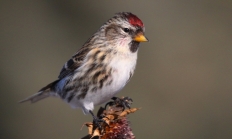
Although a common breeding bird throughout Oregon's mountains, the Pine siskin retains an air of mystery due to its highly nomadic and unpredictable movements and its fondness for the inaccessible conifer canopy. It is most familiar in winter through early spring when flocks descend to foothills and valleys to feed on alder catkin seeds and many mingle with goldfinches in weed patches and at feeders. It is readily identified by its heavily streaked plumage and by the yellow wing and tail bars that are especially prominent in flight. The Pine siskin is a generally common resident in conifer forests throughout

Formerly known as the Green-backed goldfinch, this species was either not present or overlooked during the 19th century by most Oregon ornithologists. The male's black forecrown contrasts smartly with the greenish back and bright yellow underparts. Females lack the clear contrasting colors of the males, though the tips of the secondary coverts and the base of the primaries are white in both sexes. Often the plaintive tee-yee call reveals the presence of the bird long before it is seen. In the north Willamette Valley the Lesser goldfinch is a fairly common breeder along the western fringe. Scattered and local in
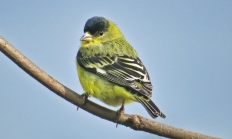
The exuberant bounding flight, musical calls, and flashy yellow and black plumage of the American goldfinch in breeding-season make them one of the most recognized and welcome of Oregon birds. Found in flocks nearly year-round, these goldfinches are a familiar site in riparian woodlands, orchards, weedy fields, and agricultural land. They are among the last of Oregon's songbirds to nest and are highly nomadic in the nonbreeding season. They may form mixed flocks with Lesser goldfinches and Pine siskins at bird feeders and weed patches throughout Oregon, as well as with Common redpolls some years in northeast Oregon. Their diet
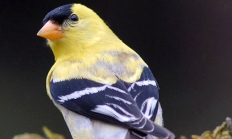
This sturdy-looking bird has a large head, short tail, and massive conical bill adapted for seed eating. The male plumage features bold patches of lemon yellow shading into olive, then brown and black, with white secondaries creating a flashy wing-patch easily seen in flight. The male's bill is chalky white in winter, but changes in early spring to a pale green that matches the new growth at the tips of spruce boughs, where they often nest. Many encounters with this species are of individuals heard flying high overhead, leaving the observer with little else to note. The Evening grosbeak is
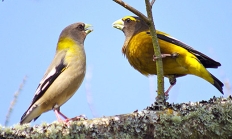
The House sparrow is an invasive species introduced from Europe. No other North American wild bird is so associated with human settlement as this introduced House sparrow. Its foods are nearly all imports, and its nesting and cover requirements are also human-derived. The House sparrow and European starling are the only introduced passerine birds that are thriving in Oregon. These birds can dominate bird feeders and utilize nest boxes that were intended for native species. The House sparrow can be found statewide around buildings at human developments of adequate size ranging from scattered farmsteads in remote and rural areas to

In Oregon, the opossum is considered an invasive species. The Virginia opossum is a cat-sized mammal with a pointed nose, unfurred, black, leathery ears with white edges; beady eyes; a hind foot with an opposable hallux (big toe); and a naked scaly tail. It was introduced in Oregon between 1910 and 1921. Populations were established in northwestern Oregon apparently from releases of animals brought to the state as pets or novelties. Small streams, forest communities, and agricultural lands planted to a variety of crops are typical of many habitats occupied by Virginia opossums in Oregon. They are active nocturnally and

Baird's shrew is a medium-sized shrew in which the third unicuspid is smaller than the fourth. This shrew is endemic to Oregon. It occurs in the Coast Range from the Pacific Ocean east to Portland and south of the Columbia River down to Corvallis. It also occurs along the west slope of the Cascade Range from the Columbia River south to central Lane County.
This shrew is the largest member of the genus in North America. Truly a water shrew, it swims easily both on the surface and while submerged, mostly by alternate strokes of the hind feet. When leaving the water, it literally springs from the surface. In Oregon, it occurs in the northern Cascade Range in Clackamas, Hood River, and Multnomah counties, then west in Clatsop, Columbia, and Washington counties along the Columbia River, and southeasterly from Newport through Benton, Lane, Linn, Jackson and Klamath counties. Habitats include alder in riparian zones, skunk cabbage marshes, deep, dark, red cedar swamps, floating mats
The Merriam's shrew is the smallest shrew in Oregon. This brownish shrew has a short, truncated skull and is medium dark-brown on the dorsum and pinkish white on the venter; the tail is sharply bicolored in the same tones as the body with dark and light portions about equal. In Oregon, it has been found in Grant, Harney, Lake, and Wasco counties. It occupies drier habitats and is reported to be associated with sagebrush-bunchgrass habitats.
The montane shrew is slightly larger and has a slightly longer tail than the vagrant shrew. It is distinctive in that the third unicuspid is smaller than the fourth. It occurs as a small population near the Columbia River and along the Pacific Coast in Clackamas, Clatsop, Columbia, Hood River, Multnomah, and Tillamook counties and as a series of populations at higher elevations in Baker, Crook, Grant, Harney, Union, Wheeler, and Wallowa counties.
The Pacific shrew is the only shrew in Oregon without a tine on the anteromedial surface of the first upper incisor but with a posteriomedial ridge visible in anterior view through the gap between the incisors. It is a large brown shrew with the third unicuspid smaller than the fourth. The species is often found in moist wooded areas with fallen decaying logs and brushy vegetation. It is endemic to Oregon and is distributed as two disjunct populations: one in the Coast Range from Cascade Head, Tillamook County, south to Coos Bay, Coos County and eastward to Philomath, Benton County
The water shrew is a large shrew with a very dark gray to black dorsal pelage, a white venter and throat, and a sharply bicolored tail. It occurs, in Oregon, as disjunct populations in the Wallowa, Blue, Ochoco, Strawberry, Steens, and Hart mountains and in the High Cascade Range west and downslope to McKenzie Bridge, Lane county. It is almost always found near water. Undercut banks, exposed tree roots, and boulder-strewn streamsides vegetated by willow, willow-grass, or willow-alder associations seem to be prime habitat. Photo by Charlie Marshall, Flickr
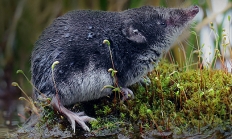
Preble's shrew is the smallest shrew in Oregon; adults commonly weigh less than a dime. The pelage is medium dark-brown to very dark-gray on the dorsum and silvery gray on the venter. The tail is bicolored, medium dark-brown on the dorsal surface, white on the ventral surface and darkening toward the tip. In Oregon, it has been found in Deschutes, Grant, Klamath, Lake, Harney, Malheur, and Wallowa counties. Its habitats include marshes, along streams, dry bunchgrass, and wet, alkaline habitat. Grasses and sagebrush are common to most habitats.
